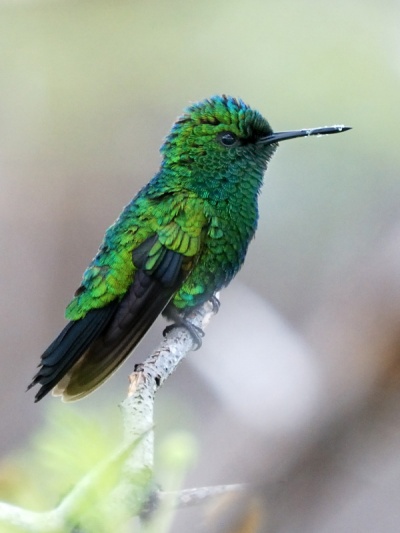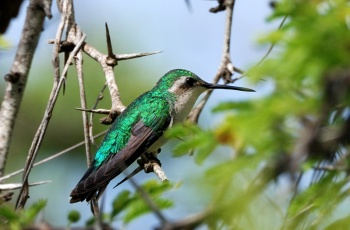
Photo © by OhioMoose
Near Santa Marta Bay, Curaçao Netherlands Antilles, November 2007
- Chlorostilbon mellisugus
Identification
Male 7·5–9·5 cm (3-3¾ in); Female 6·5–7·5 cm (2½-3 in)
Male
- Bright green
- White thighs
- Dark metallic blue tail
- Short, straight black bill
Female
- Greyish-white underparts
- Blackish ear patch
- Short white supercilium/post-ocular streak
- White-tipped outer tail feathers.
Distribution
Venezuela, Curaçao, Aruba, Bonaire, Trinidad, Margarita Island, Guyana, Brazil, Suriname, French Guiana, Colombia, Bolivia, Peru. Generally on the eastern side of the Andes and in the Amazonian Basin of the South American countries.
Taxonomy

Photo © by Stanley Jones
Villa Carmen Lodge, Pillcopata, Cusco Department, Peru, September 2018
There has been considerable reclassification of the Emerald Hummingbirds in recent years. Opus follows the taxonomic classification of Clements, which separates this species from the Western Emerald and Garden Emerald, with which it has been considered conspecific by some authorities in the past.
Subspecies
There are 6 subspecies[1]:
- C. m. caribaeus:
- C. m. duidae:
- Tepuis of southern Venezuela (Mount Duida)
- C. m. subfurcatus:
- C. m. mellisugus:
- Suriname, French Guiana and lower Amazonian Brazil
- C. m. phoeopygus:
- C. m. peruanus:
Habitat
Rain, gallery and deciduous forest, second growth, llanos, xerophytic areas, open fields with scattered trees; scrubby desert and gardens. Observed at heights between 528 and 2100m.
Behaviour
Diet
Their diet consists mostly of nectar and insects.
Breeding
They construct a small cup nest. The eggs are incubated for 13 days with the young fledging 18 days later.
References
- Clements, J. F., T. S. Schulenberg, M. J. Iliff, D. Roberson, T. A. Fredericks, B. L. Sullivan, and C. L. Wood. 2018. The eBird/Clements checklist of birds of the world: v2018. Downloaded from http://www.birds.cornell.edu/clementschecklist/download/
- BF Member observations
- Handbook of the Birds of the World Alive (retrieved December 2018)
Recommended Citation
- BirdForum Opus contributors. (2024) Blue-tailed Emerald. In: BirdForum, the forum for wild birds and birding. Retrieved 23 April 2024 from https://www.birdforum.net/opus/Blue-tailed_Emerald





